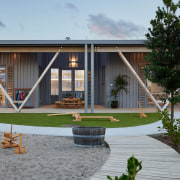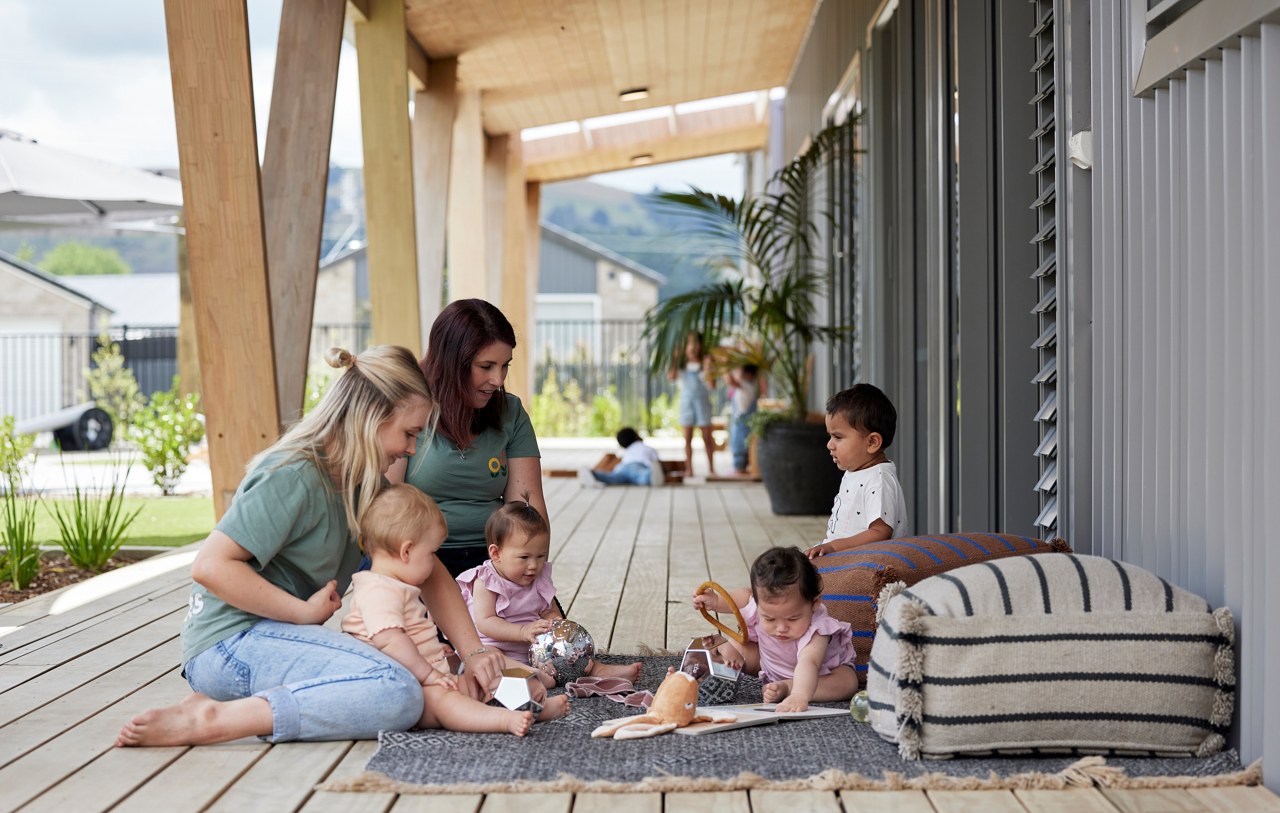It takes the children to raise a village
This early childhood education centre for 105 children by Copeland Associates Architects provides an essential community hub for a large new housing development at the southern edge of Auckland
Designed by Copeland Associates Architects (CAA)
From the architects:
The project was initiated from an innovative collaboration between New Shoots, the specialist early childhood educator, and Classic Developments, the developer of the residential subdivision which provided project finance, engaged the design team and managed the construction contract.
A triangular space in the middle of the subdivision defined by the new roading layout proved too difficult to divide up for residential units.
Forming an unusual site, it is well placed in the centre of the new community and will eventually be surrounded by houses on all sides.
The design reconciles the need to provide enough interior teaching spaces, external play areas and car parking to meet the exacting specialist’s brief and detailed legislative and licensing requirements for early childhood education.
A rectangular plan, serrated at each end to suit site constraints, is organised around a circulation corridor with ‘adult’ and service spaces to the east and more protected ‘children’ spaces to the west.
Structure is arranged to either side of this corridor, with short-span trusses to suit flat ceilings along the eastern edge and long-span trusses to accommodate high raked acoustic ceilings in the children’s spaces and reception area.
A continuous east-facing high-level window brings in morning light, energising the children’s activity spaces.
The generous roof extends to provide verandas on all four sides.
Light-coloured timber finishes to the veranda decks and soffits create warm inviting external spaces, actively encouraging children to play in the open air, shaded from the sun.
The children’s play area veranda roof is punctuated with translucent panels above the courtyard cut-out.
External play areas incorporate significant shade structures and provide an abundant variety of tactile experiences for learning and discovery.
Site and context
The project’s site is roughly triangular and approximately flat.
There are views East to the Hunua Ranges in the distance – there are no other distinctive urban landmarks in this new subdivision and so far, not even many (if any!) trees within the sea of houses.
Apart from its primary function for children, the building therefore has an important role to fulfil as a first marker or hub for a new community of dwellings.
The building has an open aspect on all sides, hence prompting the provision of generous verandas for weather protection.
Although larger than the neighbouring houses, the residential scale is maintained and the verandas signify shelter and a homely welcome onto the street.
Careful attention has been given to the external approach, to provide not just for car parking but, by separating cars and pedestrians on site, also safe walking, push-chair access and cycling.
The external playspaces have interactive and playful elements which can be glimpsed from the streets that encircle the Centre through the varying geometry of boundary fences.
The new residential subdivision contains a significant allocation of affordable housing, aiming to form an ideal neighbourhood for first-time buyers.
The project will provide a safe amenity close to the homes of many young families.
Removing the need to drive young children to other areas of the city decreases general car use and encourages more healthy forms of travel such as walking and cycling.
Additional opportunities open up for adult residents to work locally rather than commuting long distances to work.
Meeting resource consent
There were a significant number of detailed minor issues which took some time to be worked through as part of the restricted discretionary Resource Consent process.
These included:
- Several minor yard infringements resulting from the tight site area – these were mitigated by detailed design at the edges of the site (for example with visually permeable boundary fences between 1.4m - 1.8m high), together with softening the landscape.
- Transport issues, such as exceeding the permitted traffic generation threshold and the provision of three stacked parking spaces for staff – these were negotiated by demonstrating in detail that adverse effects would be less than minor.
The planners concluded that ‘the nature and intensity of the childcare centre activity will not adversely affect the amenity values and neighbourhood character of both the existing and future planned environment.’
They further commented that ‘while the building will have a larger footprint than what is typical of a residential suburban environment, this will likely be compatible with other buildings in the local environment, especially as this evolves.
This factor is assisted by the single storey scale with the building form and massing being well modulated and articulated to ensure that it sits comfortably within the future built forms and neighbourhood character.’
The resolution of the constraints involved a coordinated team of consultants – planner, traffic engineer, civil engineer, acoustic consultant, landscape architect as well as the architect.
Material selection, method of construction and impact on maintenance costs
The important role of this building is to provide light, healthy spaces for nurturing young persons in clean air and open surroundings – thus introducing future generations at their first steps to a well designed environment formed with benign materials.
Timber was chosen as the primary structure of the building, with the smallest carbon footprint in comparison to other construction products.
Wood buildings also improve air quality, humidity and even the emotional well-being and creative expression of occupants; so wherever possible, timber is exposed rather than covered over.
The majority of structural elements including engineered timber pilasters, roof trusses and wall framing were pre-fabricated, which reduced waste and site construction time – as an additional consequence, materials, components, contractors and tradesmen were all predominantly local.
Small timber seats inserted into exposed engineered timber V-struts at the veranda edge create additional play opportunities.
The colour palette acknowledges the natural timber hues while providing a neutral backdrop to the animation of the colourful furniture, toys and play equipment.
Exterior steel siding and aluminium windows are recessively coloured.
A key decision was the use of a ground concrete floor as a finish, interspersed with areas of carpet for soft activities – these choices were greatly influenced by hygiene and maintenance requirements.
Natural light and ventilation are essential ingredients.
An east-facing translucent roof strip admits diffused light, energising spaces in the mornings while avoiding solar gain in the afternoon.
The deeper western veranda and louvred windows aerate the children’s activity spaces.
A combination of high-level lighting with light coloured surfaces and cabinetry minimises the need for artificial lighting during daytime.
Low-toxicity building materials used throughout include insulation, acoustic ceiling panels and paint finishes.
Shade structures in the garden are planted with natural creepers that will permanently replace the fabric sails over time.
Key contributor
Close collaboration with New Shoots has achieved a level of continuity and integration from inside to outside through the architectural language, structure, and materiality.
The interior furnishings and bespoke furniture designed and assembled by New Shoots add texture and colour, creating a calming and playful space for children to be inspired.
The big picture – community and sustainability
The issue with a lot of large new residential developments located further out from the cities is that they move away from critical amenities such as early childhood education centres, which is usually a compromise for the buyers – this is particularly evident with first home buyers and young families, which the development is targeting.
The centre and its location provides both the social and economic sustainability to this area, serving hundreds of new homes now and in the future, having capacity for further growth.
It creates an anchor for the development and helps nurture and support growth within the community, making life much easier for the parents.
Although registration for any environmental certification standards was not part of the brief, sustainable design principles and good practices were used as aspirational targets to inform the design.
Construction works did not negatively impact any surrounding ecology.
Stormwater tanks were designed to collect roof run-off and permeable surfaces to the car parking and external play area helped minimise stormwater run-off.
Prefabricated timber trusses, engineered timber assemblies and framing helped keep construction waste to a minimum.
Non-toxic materials and finishes were carefully selected with Whole Life Carbon considerations in mind and local materials and labour were used predominantly.
Natural cross-ventilation, deep overhangs and daylight were designed to reduce operational costs by reducing artificial lighting and air-conditioning requirements.
All spaces have natural light and fresh air, with morning light maximised and afternoon solar gain minimised, hence creating healthy, productive spaces.
All habitable spaces have an outlook to landscaped spaces with operable windows and glazed doors providing visual and physical access to nature.
Timed, low-flow fixtures were used to mitigate potable water wastage.
User friendly
User comfort was key to the design of the spaces – the building is completely accessible and unisex facilities have been designed for inclusivity.
The children’s service spaces and sleep areas are geared to ensure comfort and privacy.
The building form and play area design allows easy supervision, hence reducing staff stress.
The staff room with a kitchen and screened outdoor landscaped deck creates quiet, relaxation spaces, which are crucial for staff involved with stressful work environments like an ECEC.
Credit list
Project
Project manager
Acoustic engineer
Landscape consultants
Structural engineering
Fire engineer
Lighting engineering
Translucent roofing
Soffit 1
Paint
Timber cross laminated beams
Insulation
Cabinetry
Architect
Traffic engineer
Geotech
Civil engineering
Services engineering
Interiors
Timber cladding
Soffit 2
Truss
Flooring
Designed by: Copeland Associates Architects
Story by: Trendsideas
Photography by: Amanda Aitken Photography
Home kitchen bathroom commercial design
Diving into nature
Classic looks, contemporary efficiency
Personality plus



















